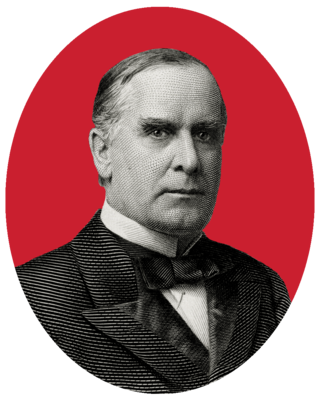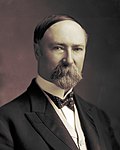Top Qs
Timeline
Chat
Perspective
1900 Republican National Convention
American political convention From Wikipedia, the free encyclopedia
Remove ads
The 1900 Republican National Convention was held June 19 to June 21 in the Exposition Auditorium, Philadelphia, Pennsylvania. The Exposition Auditorium was located south of the University of Pennsylvania, and the later Convention Hall was constructed along the building's east wall. It was demolished in 2006.



Each state was allotted two delegates per electoral vote, and territories were granted from two to six delegates. Altogether, there were 926 delegates and an equal number of alternates.
Mark Hanna opened the convention, and proposed that Senator Edward O. Wolcott of Colorado serve as temporary chairman: this was to show that the party had overcome its division in 1896, when the Colorado delegation walked out of the Republican Convention after a dispute over federal subsidies for the silver industry. Senator Henry Cabot Lodge of Massachusetts served as the convention's permanent chairman.
President William McKinley was unanimously nominated for reelection after no candidate ran against him, although Admiral George Dewey considered a run.
Governor Theodore Roosevelt of New York, who was himself a delegate, was nominated for vice president by a vote of 925 to zero, his vote alone abstaining.
Remove ads
State delegates
This section needs expansion. You can help by adding to it. (June 2019) |

The 1900 Republican National Convention included a historic first for the Republican Party: Frances Warren of Wyoming served as the party's first-ever female convention delegate.[1] Additionally Jennie L. McCargar Jones, of Utah, and Susan Henderson West of Idaho served as alternate delegates.[2][3][4]
Remove ads
Speakers
Summarize
Perspective



The 1900 convention had fewer speakers than a modern convention typically has due to lack of TV and even radio at this time. There were however the following speakers:
June 19
- Prayer by Rev. James Gray Bolton D.D.
- Senator Mark Hanna (Ohio)
- Senator Edward O. Wolcott (Colorado)
June 20
- Prayer by Rev. Charles M. Boswell D.D.
- Senator Henry Cabot Lodge (Massachusetts)
June 21
- Prayer by Most Rev. P. J. Ryan, Archbishop of Philadelphia
- Senator Joseph B. Foraker (Ohio), McKinley nominating speech
- Theodore Roosevelt, Governor of New York, McKinley seconding speech
Balloting: President McKinley was nominated unanimously. This was the first unanimous nomination since President Grant in 1872.
- John W. Yerkes, IRS Commissioner from Kentucky
- George A. Knight, attorney and businessman from California
- James A. Mount, Governor of Indiana
Boss Platt of New York wanted to be rid of reformist governor Roosevelt. He persuaded Roosevelt to accept nomination for the vacant office of Vice President.
- Lafayette Young, newspaper reporter from Iowa, Roosevelt nominating speech
- M. J. Murray, local politician from Massachusetts, Roosevelt seconding speech
- General James M. Ashton, lawyer and soldier from Washington, Roosevelt seconding speech
Balloting: Roosevelt was nominated for vice president, though he abstained from voting on his own nomination.
- Senator Chauncey Depew (New York)
Remove ads
Vice-presidential nomination
Summarize
Perspective
Vice-presidential candidates
Candidates considered
Vice President Garret Hobart had announced in September 1899 that he would not seek re-election due to declining health. In the event, he died in office on November 21, 1899, leaving the party the task of choosing a running mate for McKinley.
Entering the convention, many had expected that the ticket would consist of President McKinley and New York Governor Theodore Roosevelt.[5] However, Ohio Senator Mark Hanna maneuvered to keep Roosevelt off the ballot, instead proposing Navy Secretary John D. Long of Massachusetts or Iowa Representative Jonathan P. Dolliver.[5] Without the support of McKinley, Hanna's efforts fell short.[6] Roosevelt himself did not particularly want to abandon his position of governor, but he desired to run for president in 1904 and when the party nominated him, he accepted the position.[6] Roosevelt's nomination was spearheaded by bosses Matthew Quay of Pennsylvania and Thomas C. Platt of New York, the latter of whom wished to find a different job for the reformist Roosevelt.[6]
Vice-presidential balloting / 3rd day of convention (June 21, 1900)
- 1st
Vice-presidential ballot
Platform
The Republican party supported the current administration's actions in the Philippines, while the Democratic party promoted "anti-imperialism".
See also
References
External links
Wikiwand - on
Seamless Wikipedia browsing. On steroids.
Remove ads












